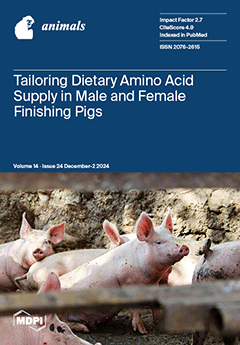In this study, we identified
Sp-ACP and its putative receptor from the mud crab
S. paramamosain and explored its potential role in ovarian development. RT-PCR results suggested
Sp-ACP was extensively expressed in nervous tissues, the ovary, the middle gut, and the Y-organ, while
[...] Read more.
In this study, we identified
Sp-ACP and its putative receptor from the mud crab
S. paramamosain and explored its potential role in ovarian development. RT-PCR results suggested
Sp-ACP was extensively expressed in nervous tissues, the ovary, the middle gut, and the Y-organ, while
Sp-ACPR was highly expressed in the ovary. The expression level of
Sp-ACP in the ovary, eyestalk, and cerebral ganglia gradually increased during ovarian development, whereas its receptor exhibited an opposite expression pattern in the ovary. Immunofluorescence revealed that ACP was specifically localized in the follicle cells of the ovary. In vitro experiments showed that the expression of vitellogenin receptor (
Sp-VgR) in the ovary was significantly increased by 4 and 6 h incubation of
Sp-ACP (10 nM). In addition, 12 h injection of
Sp-ACP significantly induced the levels of
Sp-Vg in the hepatopancreas and
Sp-VgR in the ovary, and hemolymph 17β-estradiol titer. Finally, it demonstrated that prolonged injection of
Sp-ACP significantly increased the level of
Vg and
VgR expression, hemolymph 17β-estradiol titer, GSI, and the oocyte diameter. In conclusion, our results suggested that ACP is involved in the regulation of ovarian development of
S. paramamosain, likely by inducing hepatopancreas
Sp-Vg expression through estradiol and promoting the uptake of
Vg by oocytes.
Full article






